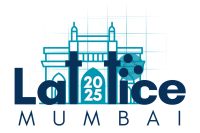Speaker
Description
The properties of QCD with massless quarks, particularly the chiral phase transition, have important implications for our understanding of QCD at the physical point. Once the number of massless fermions exceeds a critical value, $N_f^*$, QCD enters the conformal window and becomes chirally symmetric already in the vacuum. Determining $N_f^*$ has long been a challenge in lattice QCD, as simulations are performed away from the chiral and continuum limits, thus allowing spontaneous symmetry breaking and thermal transitions even for $N_f \ge N_f^*$. An additional difficulty in the relevant low-temperature region of lattice parameter space is the appearance of an unphysical bulk transition $-$ a discretization artifact that may mask the genuine thermal transition. In this work, we approach the chiral limit by mapping out the phase boundary of the chiral transition in an extended parameter space spanned by the gauge coupling, the number of unimproved staggered fermions, their masses, and the lattice spacing. Our study of the thermal phase transition suggests that, in continuum QCD, the chiral transition is of second order for all $N_f$ up to the onset of the conformal window. At the same time, by mapping out the bulk transition for various $N_f$ and analyzing its interplay with the thermal transition, we obtain a more refined picture of the general lattice phase structure. Building upon previous studies of many-flavour QCD at $T=0$ and $am=0$, we present an extended lattice phase diagram in terms of $N_t$, $\beta$, $am$, and $N_f$. This understanding of how the conformal window connects to lattice QCD at finite spacing and mass might provide new strategies for inferring the onset of the conformal window from simulations performed away from the chiral and continuum limits.
| Parallel Session (for talks only) | QCD at nonzero temperature and density |
|---|

